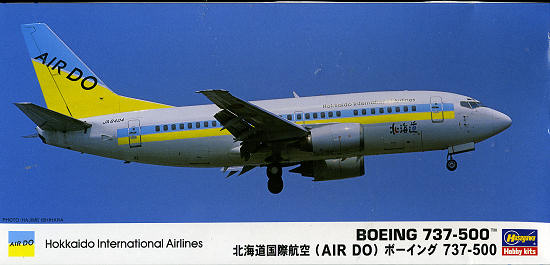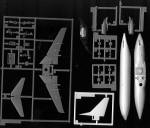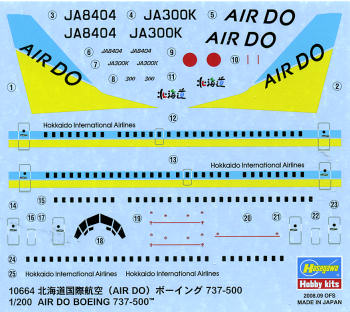
Hasegawa 1/200 Boeing 737-500 'Air Do'
| KIT #: | 10664 |
| PRICE: | $ |
| DECALS: | Two options |
| REVIEWER: | Scott Van Aken |
| NOTES: | Kit includes a stand |

| HISTORY |
First envisioned in 1964, the 737 entered service in 1968. Forty years later it has become the most ordered and produced commercial passenger jet in the world. It is Boeing's last surviving narrow-body airliner, sometimes serving markets previously filled by 707, 727, 757, DC-9 and MD-80/90 airliners. Continuously manufactured by Boeing since 1967 with over 8,000 ordered and over 5,800 delivered as of 2008, there are over 1,250 737s airborne at any given time. On average, a 737 departs or lands somewhere every five seconds.
After the success of the Boeing 737-200 Advanced, Boeing wanted to increase capacity and range, incorporating improvements to upgrade the plane to modern specifications, while also retaining commonality with previous 737 variants. Development began in 1979, and in 1980 preliminary aircraft specifications were released at the Farnborough Airshow. In March 1981 USAir and Southwest Airlines each ordered 10 aircraft, with an option for 20 more.
The new series featured CFM56 turbofan engines, which yielded significant gains in fuel economy and a reduction in noise, but also posed an engineering challenge given the low ground clearance of the 737. Boeing and engine supplier CFMI solved the problem by placing the engine ahead of (rather than below) the wing, and by moving engine accessories to the sides (rather than the bottom) of the engine pod, giving the 737 a distinctive non-circular air intake.
The wing incorporated a number of changes for improved aerodynamics. The wing tip was extended 9 in (23 cm). The leading-edge slots and trailing-edge flaps were adjusted. The flight deck was improved with the optional EFIS (Electronic Flight Instrumentation System), and the passenger cabin incorporated improvements similar to those on the Boeing 757.
The 737-300/400/500 aircraft are all considered the '737 Classic' series and have since been replaced by newer variants on the production line.
The -500 series was offered, due to customer demand, as a modern and direct replacement of the 737-200. It incorporated the improvements of the 737 Classic series; allowing longer routes with fewer passengers to be more economical than with the 737-300. The fuselage length of the -500 is 1 ft 7 in (47 cm) longer than the 737-200, accommodating up to 132 passengers. Both glass and older style mechanical cockpits arrangements were available. Using the CFM56-3 engine also gave a 25% increase in fuel efficiency over the older -200s P&W engines.
The 737-500 was launched in 1987 by Southwest Airlines, with an order for 20 aircraft, and flew for the first time on 30 June 1989. A single prototype flew 375 hours for the certification process, and on 28 February 1990 Southwest Airlines received the first delivery. The 737-500 has become a favorite of some Russian airlines, with Aeroflot-Nord, S7 Airlines, and Rossiya Airlines all buying second-hand models of the aircraft to replace aging Soviet-built aircraft.
| THE KIT |
 Hasegawa
first issued its 'Loveliner' series of 1/200 airliners back in the late 1970s.
At the time, the aircraft had raised panel detail, open cabin windows, and
landing gear that could only be modeled in the 'down' position. This latter
feature required the modeler to expend considerable effort to do a wheels up
display, as often times main gear doors folded into each other when the gear was
down. As cabin window configuration was not always the same, it would require
the modeler to fill in those not needed. However, this was not a problem for a
number of modelers who liked this feature.
Hasegawa
first issued its 'Loveliner' series of 1/200 airliners back in the late 1970s.
At the time, the aircraft had raised panel detail, open cabin windows, and
landing gear that could only be modeled in the 'down' position. This latter
feature required the modeler to expend considerable effort to do a wheels up
display, as often times main gear doors folded into each other when the gear was
down. As cabin window configuration was not always the same, it would require
the modeler to fill in those not needed. However, this was not a problem for a
number of modelers who liked this feature.
This latest in the series has no cabin windows,
no cockpit window,
optional 'wheels up' landing gear door parts, and fully engraved detailing.
Things that are not changed are the inclusion of a display stand and a heft
weight for those building the kit with wheels down. In fact, the kit is designed
to be put on the stand as there is a large hole in the bottom of the fuselage
for the attachment point. For display on the ground, this will need to be filled
in. The main gear legs have the doors molded as part of the assembly. I also
like that this particular boxing has one piece engine/pylon combinations. No
need to be
 concerned
about filling an intake seam. The front fan pieces simply plug in as the exhaust
is molded in with the engine.
concerned
about filling an intake seam. The front fan pieces simply plug in as the exhaust
is molded in with the engine.
Tail planes are one piece as are the wings on this version because they are so short. Thanks to the option for wheels up, one can build this in flight, something that many airliner fans can appreciate. Probably the biggest difference from 'standard' airliner kits is that this one has the fuselage split horizontally. Not sure how much that will change things, but it does move the seam to where it will be under the window and cheat-line decals.
Instructions are standard Hasegawa and use Gunze paint references. The planes are basically overall white with medium grey wings, tailplanes and engines. The decals are very nicely printed and allow one of two Air Do aircraft. Of course, cabin and cockpit windows are included. For those who'd rather paint on the light blue and yellow, separate windows and livery markings are provided. The decals are the latest new wave type and should react favorably to setting solutions. The simple livery would make this an ideal first airliner for someone
| CONCLUSIONS |
Obviously these kits sell well. This one is superbly molded and at a Japanese price of 1800 yen, is a good buy in the home country. Thanks to the general simplicity of this one, I can recommend it even to the newest airliner modeler.
| REFERENCES |
http://en.wikipedia.org
November 2008
My thanks to
www.dragonmodelsusa.com for the preview kit. Get yours
today at your favorite hobby shop or on-line store. If you would like your product reviewed fairly and quickly, please
contact
me or see other details in the
Note to
Contributors.